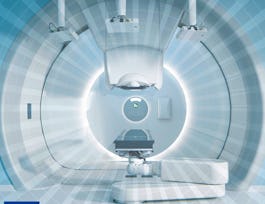Did you know that particle accelerators play an important role in many functions of todays society and that there are over 30 000 accelerators in operation worldwide? A few examples are accelerators for radiotherapy which are the largest application of accelerators, altogether with more than 11000 accelerators worldwide. These accelerators range from very compact electron linear accelerators with a length of only about 1 m to large carbon ion synchrotrons with a circumference of more than 50 m and a huge rotating carbon ion gantry with a weight of 600 tons!


Fundamentals of particle accelerator technology (NPAP MOOC)
Taught in English
Some content may not be translated
4,800 already enrolled
(96 reviews)
Recommended experience
What you'll learn
You will learn the basic technology of particle accelerators.
You will understand the basic principles for how particles are accelerated, and how they can be guided.
You will learn about different ways to monitor the beam.
You will learn about vacuum: Why we need vacuum in accelerators; Where particles that give rise to pressure comes from; How one create vacuum
Details to know

Add to your LinkedIn profile
51 quizzes
See how employees at top companies are mastering in-demand skills


Earn a career certificate
Add this credential to your LinkedIn profile, resume, or CV
Share it on social media and in your performance review

There are 5 modules in this course
This module is an introduction to the RF systems of particle accelerators. RF stand for radio frequency and indicates that the systems deal with electromagnetic waves with frequencies that are common for radio systems. The RF system generates electromagnetic waves and guides them down to cavities. The cavities are located along the beam pipe such that the particles pass through the cavities when they travel along the accelerator. When the waves enter the cavity they create as standing wave inside the cavity. it is the electric field of this standing wave that accelerates the particles. In the module we describe the amplifier, which generates and amplifies the electromagnetic waves. We describe different types of waveguides which transport the waves from the amplifier to the cavity. We also describe the most common types of cavities. Most of the system is described without equations but in the texts following the lectures you will find some of the theory for the RF-system.
What's included
14 videos10 readings15 quizzes
This module is about the types of magnets that are used in particle accelerators. It introduces dipole magnets, quadrupole magnets, sextupole magnets and octupole magnets, and describe where these are needed and how they are designed. In the most common types of magnets, the magnetic field are produced by currents running in normal conducting wires. When large magnetic fields are required one use superconducting magnets and the module describe how these are designed. There are also cases when quite weakl magnetic fields are required and then one can use permanent magnets. This a green alternative since they have zero power consumption. The permanent magnets are also covered in this module.
What's included
4 videos1 reading5 quizzes
In this module we describe how we can measure and monitor various beam parameters in a particle accelerator. We introduce a few examples of common instruments for each specific parameter, starting with beam intensity and beam position, followed by transverse distribution and beam emittance. We also present ways to monitor the longitudinal and the energy distribution. The last section describe how we can determine the amount of particles that the beam loose as it travels through the accelerator.
What's included
19 videos3 readings20 quizzes
This module gives an introduction to basic concepts of vacuum physics and techniques in accelerators. Vacuum regions and the behavior of residual gas in these regions are described. Important phenomena, such as velocity distribution, average collision distance and molecular formation are explained by Maxwell-Boltzmann theory. These phenomena are used to determine vacuum criteria for accelerator systems. Basic concepts of vacuum pumps will be described, and different types of vacuum equipment will be presented. The objective is that the students would understand the behavior of residual gas in Vacuum systems. They should be able to determine Vacuum criteria for a given system. They should also be able to choose proper equipment for Vacuum generation and measurement.
What's included
11 videos1 reading11 quizzes
What's included
1 reading
Instructors


Offered by
Recommended if you're interested in Electrical Engineering

Lund University

Coursera Project Network

Lund University
Why people choose Coursera for their career




Learner reviews
Showing 3 of 96
96 reviews
- 5 stars
67.70%
- 4 stars
30.20%
- 3 stars
0%
- 2 stars
1.04%
- 1 star
1.04%

Open new doors with Coursera Plus
Unlimited access to 7,000+ world-class courses, hands-on projects, and job-ready certificate programs - all included in your subscription
Advance your career with an online degree
Earn a degree from world-class universities - 100% online
Join over 3,400 global companies that choose Coursera for Business
Upskill your employees to excel in the digital economy
Frequently asked questions
Access to lectures and assignments depends on your type of enrollment. If you take a course in audit mode, you will be able to see most course materials for free. To access graded assignments and to earn a Certificate, you will need to purchase the Certificate experience, during or after your audit. If you don't see the audit option:
The course may not offer an audit option. You can try a Free Trial instead, or apply for Financial Aid.
The course may offer 'Full Course, No Certificate' instead. This option lets you see all course materials, submit required assessments, and get a final grade. This also means that you will not be able to purchase a Certificate experience.
When you purchase a Certificate you get access to all course materials, including graded assignments. Upon completing the course, your electronic Certificate will be added to your Accomplishments page - from there, you can print your Certificate or add it to your LinkedIn profile. If you only want to read and view the course content, you can audit the course for free.
You will be eligible for a full refund until two weeks after your payment date, or (for courses that have just launched) until two weeks after the first session of the course begins, whichever is later. You cannot receive a refund once you’ve earned a Course Certificate, even if you complete the course within the two-week refund period. See our full refund policy.





